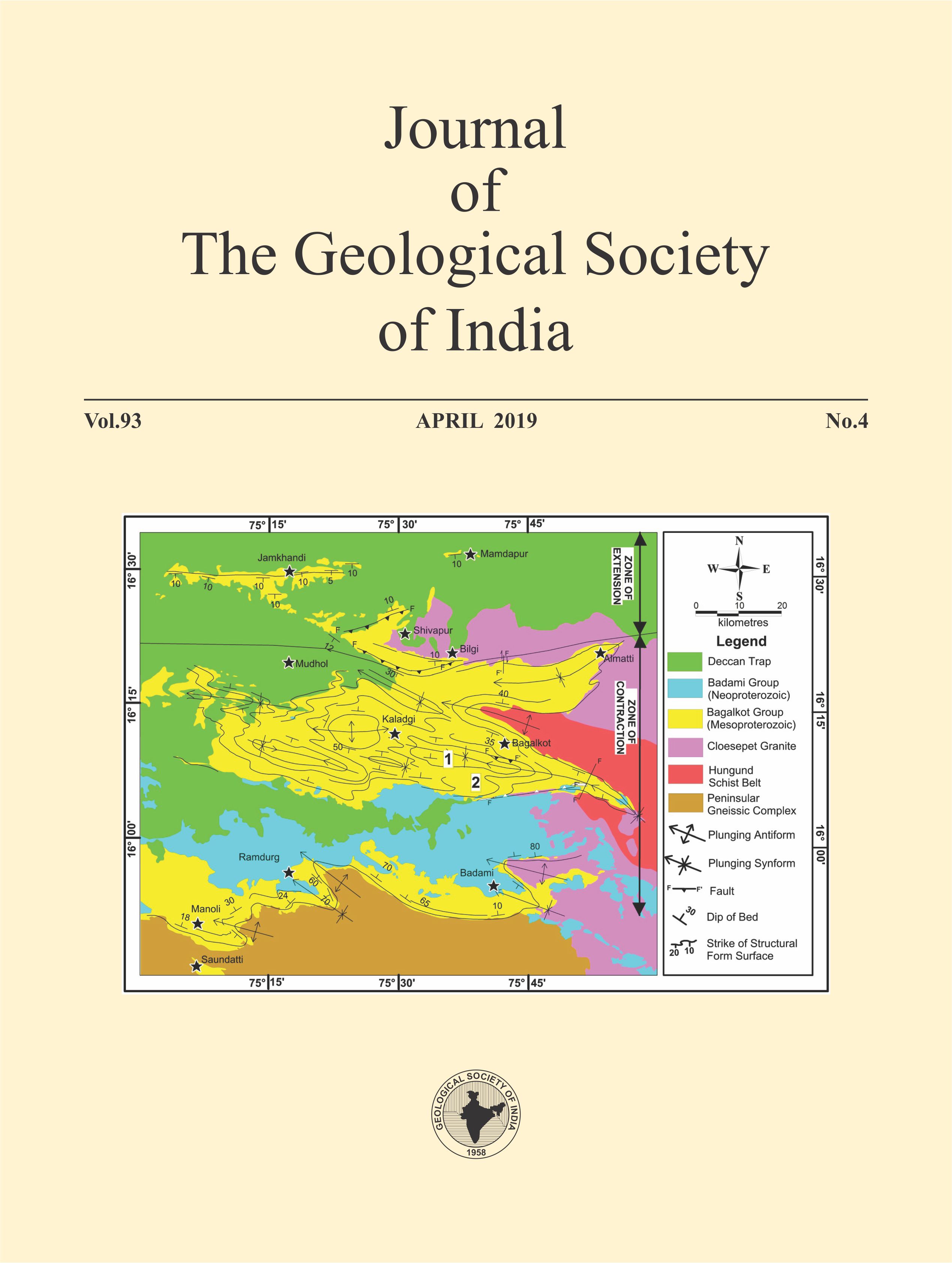Uranium Mineralization in Leucogranite of Mastipuram Area, Wanaparti District, Telangana – A New Find
DOI:
https://doi.org/10.1007/s12594-019-1204-yKeywords:
No KeywordsAbstract
The NNW-SSE trending leucogranites in and around Mastipuram, Wanaparthi district, Telangana are intrusive into Peninsular Gneissic complex. The leucogranite is metaluminous to mildly peraluminous, alkali-feldspar granite with I-type signatures, probably formed from a fractionated melt involving crustal component. Magmatic and hydrothermal contributions are supported by wide range of U/Th ratios in mineralized samples, which also show Na-enrichment as compared to non-mineralized leucogranites. Average U and Th contents and U/Th ratio in mineralized leucogranite is 541ppm, 147 ppm and 2.85, respectively. Main ore mineral is uraninite and its altered form - gummite, while secondary uranium minerals such as schoepite, uranophane and haiweeite are also identified in leucogranite by XRD. Reconnoitory drilling of ten boreholes have confirmed sub-surface continuation of uranium mineralization with varying width of 1m to 31m at vertical depth of about 50m. Thus, the leucogranites bordering Gadwal schist belt around Mastipuram forms a very potential target.Downloads
Metrics
Issue
Section
Downloads
Published
How to Cite
References
Batchelor, R.A. and Bowden, P. (1985) Petrogenetic interpretation of granitoid rocks series using multicationic parameters.Chem. Geol., v.48, pp.43-55.
Bisht, B.S., Rajasekaran, P. and Sinha, R.M. (2001) Fluid inclusion characteristics of unconformity related uranium mineralisation, LambapurPeddagattu area, Andhra Pradesh, India. Jour. Geol. Soc. India, v. 58, pp.
-51.
Condie, K.C. (1989) Plate tectonics and crustal evolution. Pergamon Press, New York, 476p.
Dhana Raju, R., Umamaheswar, K., Thirupathi, P.V., Deshmukh, R.D., Rai, A.K., Harikrishnan, T. and Patel, P.K. (2001) Characterisation of the granitoids in the south-western environs of Cuddapah Basin, Andhra Pradesh, India and its bearing on uranium mineralization. Jour. Atom. Min. Sci, v.7, pp.1-11.
Frondel, C. (1958) Systematic mineralogy of Uranium and Thorium. Geol. Surv. Bull., no.1064, 400p.
King, W. (1872) Kudapah and Karnul Formations in the Madras Presidency. Mem. Geol. Surv. India, v.8(1), 346p.
Kulshrestha, S.C. (1961) Report on the investigations carried out in Gadwal Taluk, Mehaboobnagar distrct, Andhra Pradesh. Unpublished Annual Report of AMD.
Maniar, P.D. and Piccoli, P.M. (1989) Tectonic discrimination of granitoids. Bull. Geol. Soc. America, v.101, pp.635-643.
Mason, B. and Moore, C.B. (1991) Principles of Geochemistry. 4th Edition, Wiley Eastern Limited, 350p.
Morad, S., El-Ghali, M.A.K., Caja, M.A., Sirat, M., Al-Ramadan, K. and Mansurbeg, H. (2009) Hydrothermal alteration of plagioclase in granitic rocks from Proterozoic basement of SE Sweden. Geol. Jour.(www.interscience.wiley.com).
Nagaraja Rao, B.K., Rajurkar, S.T., Ramlingaswamy, G. and Ravindra Babu, B. (1987) Stratigraphy, structure and evolution of the Cuddapah basin, In: Purana Basins of Peninsular India. Mem. Geol. Soc. India, no.6, pp.3386.
Pryer, L.L. and Robin, P.Y.F. (1996) Differential stress control on the growth and orientation of flame perthite: A palaeostress-direction indicator. Jour. Struc. Geol. v.18(9), pp.1151-1166.
Rao, K.B. (1962) Report on the radioactive granites of Anantapur (Gadwal), Mehabubnagar district, Andhra Pradesh. Unpulbld. Annual Report of AMD.
Skjerlie, K.P. and Johnston, A.D. (1992) Vapour-absent melting at 10 kbar of a biotite- and amphibole-bearing tonalite gneiss: implications for the generation of A-type granites. Geol., v.20, pp.263-266.
Skjerlie, K.P. and Johnston, A.D. (1993) Fluid-absent melting behaviour of a F-rich tonalitic gneiss at midcrustal pressures: implications for the generation of anorogenic granites. Jour. Petrol., v.34, pp.785-815.
Shand, S.J. (1943) The Eruptive rocks: 2nd Edition, John Wiley, New York, 444p.
Shrivastava, V.K., Parthasarathy, T.N. and Sinha, K.K. (1992) Geochemical studies of uraniferous granitoids from Lambapur area, Nalgonda district, Andhra Pradesh, India. Expl. Res. Atom. Min., v.5, pp.41-52.
Sinha, R.M., Parthasarathy, T.N. and Dwivedi, K.K. (1996) On the possibility of identifying low cost, medium grade uranium deposits close to the Proterozoic unconformity in the Cuddapah basin, Andhra Pradesh, India. IAEA-TECDOC-868, pp.35-55.
Stuckless, J.S. and Ferreira, C.P. (1985) Labile uranium in granitic rocks, IAEA-SM-208/17.
Taylor, S.R. (1965) The application of trace element data to problems in petrology. Phy. Chem. Earth, v.6, pp.133-213.
Viswanathan, S. and Singh, Yamuna (2010) Critical element ratio maps of granitic terrains for exploration of atomic minerals. Jour. Appl. Geochem., v.12(3), pp.333-341.
Zakaulla, S., Rai, A.K. and Umamaheswar, K. (2012) Characteristics of basement granitoids and their role on uranium mineralization in and around southwestern margin of Cuddapah Basin, Andhra Pradesh. Expl. Res. Atom. Min., v.22, pp.123-139.

 H.S. Rajaraman
H.S. Rajaraman






